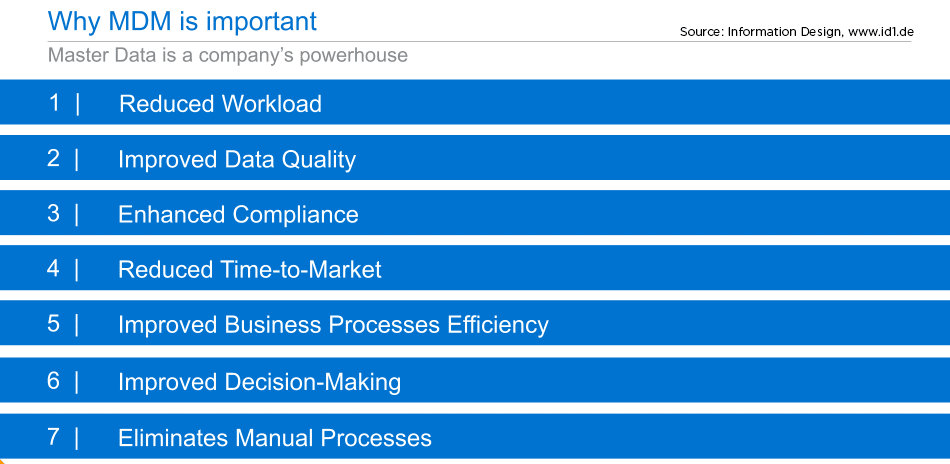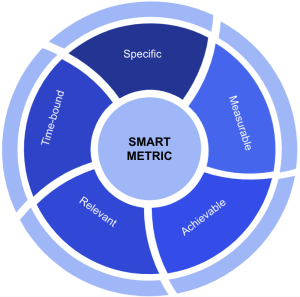Everyone Needs Master Data Management (MDM), But Don’t Call It That

Everyone Needs Master Data Management (MDM), But Don’t Call It That
A few weeks ago I was speaking to a senior executive in one of the largest global consulting firms and his comment— “Everyone needs MDM but don’t call it MDM” — gave me immediate food for thought.
We had been discussing the recent increase in demand for data management technical skills and experience in the marketplace and why enterprise MDM (master data management) specifically is experiencing a revival of interest.
Very few people would disagree that the benefits MDM promises—better data quality, reduced workload in managing data, increased compliance, improved decision-making, reduced manual effort, improved business efficiency, and more—are all desirable. However, many large enterprises have run MDM projects over the last 10-15 years, and some of these projects have gained MDM implementations a reputation for being long, expensive, and painful. Even worse, very often they have been abandoned part way through because no one can remember what they were supposed to be delivering or the value of the MDM project has been impossible to prove.

In a world where data—particularly for analytics, AI and ML initiatives—is even more important than ever before, the need for it to be mastered, trusted, and delivered in real time at scale across the enterprise just becomes more pressing. So why does MDM carry so much baggage from the past? What are the outcomes it can provide, and what’s the least painful way to deliver these outcomes?
Based on our experience at Reltio, here are three approaches to consider when planning the success of your MDM project:
- Focus on business case versus data domain: In the past MDM vendors, IT delivery teams, and pretty much everyone involved in an MDM project focused on individual data domains (also called entities); for example, customer, organisation, product, location. This is because most technology that is used to create the “golden record” or “single view” is really good at mastering single domains for a particular purpose. For example, your ERP system is probably great at products and suppliers; your CRM system is pretty good at customers; your customer data platform (CDP) is wonderful for digital consumers, and so on. And there will no doubt be multiple other systems and spreadsheets containing data like location, asset, or transaction information distributed around the business. That is how legacy MDM systems are often sold—by focusing tightly on domain or entity type (e.g., customer)—which means ignoring multiple other pieces of information that are connected to it. It also involves a lot of (***JARGON ALERT***) technical discussions about data models, relational database tables, deltas, and batch data loads. As a result, it was perhaps unsurprising that business people decided that the projects were the realm of IT and disassociated themselves with these “boring, unsexy, not needed” activities. The most important thing for those of us in the MDM world to remember when talking to business people is that they have no interest in MDM. What gets them excited, what drives success for them, what gets them promoted are business outcomes delivered against a specific use case….….But there’s the rub:
How can you improve operational efficiency in a B2B selling use case if you can’t link account and contact so your sellers know which individuals work for which company?
How can you increase cross-sell and upsell in a B2C loyalty management use case if you can’t connect customer, product, and possibly also the location (retail outlet)?
How will you upgrade your customer satisfaction in your maintenance programme if you don’t know which product each client bought and which engineer’s territory it is in?
All of these use cases—and most others in any business—involve multiple pieces of interconnected data from different domains or entity types. In Reltio’s experience, the most successful business outcomes are derived from projects where the MDM solution caters to multiple domains and focuses on the business outcomes.
- Track agreed-upon, SMART metrics: One very important element of this focus on business outcomes should be the agreement, in advance, of the SMART (Specific, Measurable, Achievable, Relevant and Time-bound) business metrics that will be used to build the ROI investment case and that will be the benchmarks for value realisation of the project. It is very difficult to reverse engineer the metrics for MDM, and how can you prove success if you cannot measure it?
 The numbers must be agreed upon by both the business and the technical teams—as well as your executives—then constantly referred to and revised as needed throughout the process of delivery. Starting the project with an objective such as, “We want to achieve a 360-degree view of the customer” is not a SMART metric and will be very difficult to define as “achieved.” Better examples we have seen in our customer base include:
The numbers must be agreed upon by both the business and the technical teams—as well as your executives—then constantly referred to and revised as needed throughout the process of delivery. Starting the project with an objective such as, “We want to achieve a 360-degree view of the customer” is not a SMART metric and will be very difficult to define as “achieved.” Better examples we have seen in our customer base include:
- Support a 3% increase in monthly loyalty guest spend
- Reduce operating expenses by $6 million through the removal of legacy data management systems and processes
- Increase sales quota attainment by 8% via enhanced information about each client
- Increase growth in loyalty base by 12% via in-app self-service and real-time offer functions
- Follow a journey that delivers value in stages across the enterprise: Value drivers for MDM that Reltio sees within our customer base include operational efficiency, customer experience, and risk and compliance; and it is very common for projects to deliver incrementally over time. For example, a high-tech client started by mastering their B2B customers and then progressed to mastering individual contacts within those organisations. This enabled them to:
- Reduce operational costs through better management of leads data because everything had been very manual
- Increase the conversion rates of leads to sales during the trial period
- Provide a unified set of trustworthy customer attributes from across all their internal systems and enrich it with third-party attributes
- Deliver it in real-time to their Salesforce CRM for account planning processes
Another customer —a global printer and computer manufacturer—began with mastering B2B organisational clients to align sales territories and more effectively plan and manage sales compensation and compliance issues. Having reduced manual sales compensation calculations from over 90% to under 10% globally, they then progressed to master their B2C customers. This client now has more than 1 billion records under management and is continually finding new ways to drive value across their business.
There are multiple ways that an enterprise MDM solution can continue to deliver value over time because it provides a foundation for your entire business. A recent survey for BI and analytics professionals, which you can find here, emphasises that when performing BI/analytics/AI/ML, “Companies can only unlock the full economic potential of their data if the master data is well managed and provided in high quality.” They also go on to provide several examples of other areas where MDM can provide value:
… to easily integrate systems following corporate mergers and acquisitions;
… to cooperate effectively with business partners;
… to provide an optimal customer experience;
… to build a 360-degree customer view that addresses customer needs in the best way possible;
… to merge on-premises and cloud-based systems.
Conclusion – should we keep calling it MDM?
The difference between MDM projects that work and the ones that don’t seems to be determined by a number of key factors, which in our experience include:
- They are sold by business use case—NOT by the data domain
- The deliverables are signed off by the business and IT in advance—and continuously referred to and measured throughout
- It’s seen as a journey—they deliver value in stages across multiple MDM domains or entity types
On the basis of this, since the focus is on business use cases, delivered against business metrics, and delivering value over time, it can sometimes be a good idea not to mention MDM at all—particularly to the business people.
In one of our global clients, thousands of sales reps log into their CRM system every day to research the physicians they are going to contact that day. They are able to find out all about those physicians—where they work, what they’ve authored, the drugs they have recommended, and much more in order to have an optimised meeting experience with their clients and prospects.
In addition, if they add a new contact record and it’s a duplicate, they are advised of that and asked if they want to go ahead via a simple “search before create” mechanism. For each of these contacts, the communication and consent preferences are stored and updated in real time so the sales reps can be clear about what they are and are not allowed to use in terms of getting in touch. None of those sales reps know that Reltio is sitting behind the interfaces they use every day—master data management is not something they are familiar with or probably ever wish to be! It’s a business use case about how to increase the effectiveness of every sales interaction, enhance customer experience, and optimise cross-sell and upsell while driving new business. So they don’t call it MDM, and neither should we.
At Reltio, we and our experienced partners would love to chat with you and your teams about how we can help you achieve your business goals on an ongoing basis, against agreed metrics. We’ll be enabling that with our cloud-native, real-time MDM technology as part of your project. We’ll be helping you to accelerate the value of your data to meet your business objectives. But let’s not include MDM in the project name!
Get in touch with us today to discuss how we can help you and your organisation get more value from your data and rapidly achieve your business goals.